Defector's bombshell
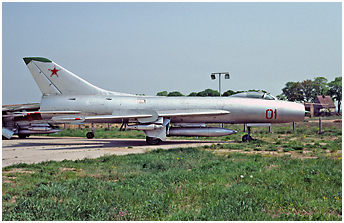 The West did not receive detailed information about air-delivered nuclear weaponry in the GDR until a Soviet deserter
defected on 27 May 1973. This was the spectacular escape by the technical officer of the 497.IBAP from Grossenhain
with a Su-7BM "Fitter-A." The 22-year-old Lt Yevgeni Lvoitch had only a little flying experience at the time he set
course to West Germany on the last Sunday in May 1973. After a short flight of 15 minutes, he ejected close to
Braunschweig and allowed his aircraft to crash into a popular recreation area near Klein Schöppenstedt. He had barely
been rescued when he applied for political asylum. "The Bundeswehr is coveting the foreigner as if he were the most
important person authorised to know secret information' was a remark in the local paper, the Braunschweiger
Zeitung, the next day. As spectacular as his escape seemed to the average person, the information he provided
to Western intelligence agencies over the next few weeks turned out to be an absolute bombshell. Until Lvoitch's
escape, the Western intelligence agencies had basically been guessing exactly where the nuclear weaponry of Soviet
Frontal Aviation was being stored. As one participant in the questioning of the Soviet defector sums it up, 'The
report was the first solid proof of the storage of atomic weaponry by the Frontal Aviation of the Sovet Union!."
(Visit the link "The Sukhoy fallen from the sky " in the second part of the chapter "3.3 Ground-Attack Aviation & Fighter-Bombers").
The West did not receive detailed information about air-delivered nuclear weaponry in the GDR until a Soviet deserter
defected on 27 May 1973. This was the spectacular escape by the technical officer of the 497.IBAP from Grossenhain
with a Su-7BM "Fitter-A." The 22-year-old Lt Yevgeni Lvoitch had only a little flying experience at the time he set
course to West Germany on the last Sunday in May 1973. After a short flight of 15 minutes, he ejected close to
Braunschweig and allowed his aircraft to crash into a popular recreation area near Klein Schöppenstedt. He had barely
been rescued when he applied for political asylum. "The Bundeswehr is coveting the foreigner as if he were the most
important person authorised to know secret information' was a remark in the local paper, the Braunschweiger
Zeitung, the next day. As spectacular as his escape seemed to the average person, the information he provided
to Western intelligence agencies over the next few weeks turned out to be an absolute bombshell. Until Lvoitch's
escape, the Western intelligence agencies had basically been guessing exactly where the nuclear weaponry of Soviet
Frontal Aviation was being stored. As one participant in the questioning of the Soviet defector sums it up, 'The
report was the first solid proof of the storage of atomic weaponry by the Frontal Aviation of the Sovet Union!."
(Visit the link "The Sukhoy fallen from the sky " in the second part of the chapter "3.3 Ground-Attack Aviation & Fighter-Bombers").
Better intelligence
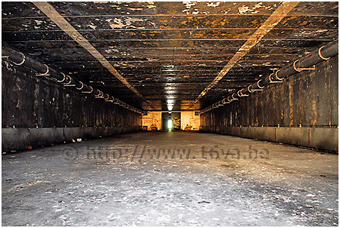 L'intérieur d'un abri de premičre génération de Type 641 pour armes nucléaires ŕ Finsterwalde. Jusqu'ŕ 80 bombes
pouvaient y ętre stockées dans un environnement régulé par air conditionné. © S.Meeter.
L'intérieur d'un abri de premičre génération de Type 641 pour armes nucléaires ŕ Finsterwalde. Jusqu'ŕ 80 bombes
pouvaient y ętre stockées dans un environnement régulé par air conditionné. © S.Meeter.
A look inside a long-deserted Type 641 air-conditioned storage room of the first generation. Up to
80 nuclear bombs could be stored in a bomb-proof environment. © S.Meeter.
NATO and Western intelligence were, from mid-1973, well informed about all Soviet air bases in Eastern Europe that
stored nuclear weapons, either on base or in the immediate vicinity. It also became possible to better interpret
certain information coming out of the Soviet Union and to deduce conclusions about nuclear weapon storage facilities.
This is shown by a classified CIA internal study dating from 1975 concerning "Warsaw Pact Forces opposite NATO."
That the language in the study was more specific than in previous years is very conspicuous: "Numerically, the most
important nuclear delivery systems in Eastern Europe are Soviet tactical aircraft. We have identified some 20
Soviet tactical air unit in East Germany, Poland and Czechoslovakia which - based on their training and exercise
activities - are believed to have a mission of delivering nuclear bombs.
There are about 850 combat aircraft assigned to these units."
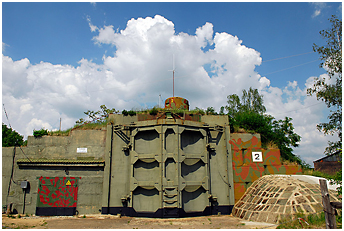 "There is good evidence, however, that only about 300 of the pilots, the most experienced,
in these units are qualified - according to Soviet standards - to drop nuclear bombs. We expect that the number
of Soviet tactical aircraft in Eastern Europe with nuclear missions will continue to grow as they train
nuclear-capable aircraft such as the MiG-23 'Flogger' and Su-17 "Fitter." Even without the naming of specific locations,
with the distinction between permanent and temporary facilites the West was nevertheless able to radically
improve its knowledge of Soviet nuclear weapons storage in 1979, as shown in the following: "There are 23
Soviet storage sites in Eastern Europe, at least some of which almost certainly contain nuclear weapons.
Eleven of them are located at Soviet tactical airfields, and 12 are isolated installations for the storage of
warheads for tactical missiles and rockets [for ground forces]."
"There is good evidence, however, that only about 300 of the pilots, the most experienced,
in these units are qualified - according to Soviet standards - to drop nuclear bombs. We expect that the number
of Soviet tactical aircraft in Eastern Europe with nuclear missions will continue to grow as they train
nuclear-capable aircraft such as the MiG-23 'Flogger' and Su-17 "Fitter." Even without the naming of specific locations,
with the distinction between permanent and temporary facilites the West was nevertheless able to radically
improve its knowledge of Soviet nuclear weapons storage in 1979, as shown in the following: "There are 23
Soviet storage sites in Eastern Europe, at least some of which almost certainly contain nuclear weapons.
Eleven of them are located at Soviet tactical airfields, and 12 are isolated installations for the storage of
warheads for tactical missiles and rockets [for ground forces]."
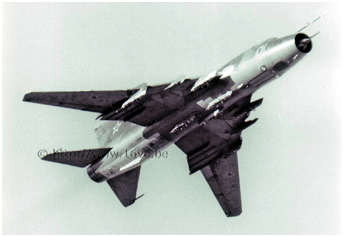
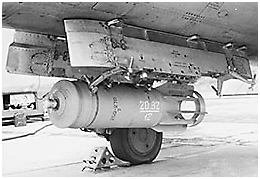 "The Soviets are estimated to have storage capacity
for only 200 to 505 nuclear bombs in East Germany, 70 to 185 in Poland, and 30 to 95 in Czechoslovakia [for
Frontal Aviation]. They probably plan to move additional bombs and warheads into the forward area from the
numerous tactical nuclear weapons storage sites in the eastern USSR before or during hostilites. We have identified
bunkers at 12 Soviet tactical airfields [temporary nuclear weapon storage facilities] in Eastern Europe which
may be intended for nuclear bomb storage during a crisis or in wartime. Although these facilities do not appear
to be active in peacetime, they probably could be readied within hours to receive nuclear bombs transferred
from the USSR." There was no mention of storage capabilities in Hungary, but it's safe to assume that
there was a capacity of between 70 and 185 atomic bombs. These were divided between two air bases, Kiskunlachaza (one-third)
and Kunmadaras (two-thirds), together with the three temporary storage facilities at Tököl, Sarmellek and
Debrecen. In the latter half of the 1970s it was assumed, based on qualification levels, that every third
pilot was qualified to attack with atomic bombs.
"The Soviets are estimated to have storage capacity
for only 200 to 505 nuclear bombs in East Germany, 70 to 185 in Poland, and 30 to 95 in Czechoslovakia [for
Frontal Aviation]. They probably plan to move additional bombs and warheads into the forward area from the
numerous tactical nuclear weapons storage sites in the eastern USSR before or during hostilites. We have identified
bunkers at 12 Soviet tactical airfields [temporary nuclear weapon storage facilities] in Eastern Europe which
may be intended for nuclear bomb storage during a crisis or in wartime. Although these facilities do not appear
to be active in peacetime, they probably could be readied within hours to receive nuclear bombs transferred
from the USSR." There was no mention of storage capabilities in Hungary, but it's safe to assume that
there was a capacity of between 70 and 185 atomic bombs. These were divided between two air bases, Kiskunlachaza (one-third)
and Kunmadaras (two-thirds), together with the three temporary storage facilities at Tököl, Sarmellek and
Debrecen. In the latter half of the 1970s it was assumed, based on qualification levels, that every third
pilot was qualified to attack with atomic bombs.
| 16.VA nuclear potential in 1977 |
"Dual-role" MiG-21s
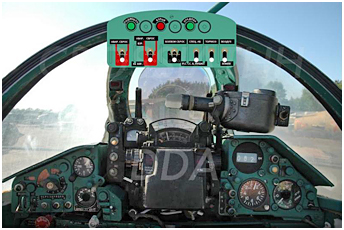
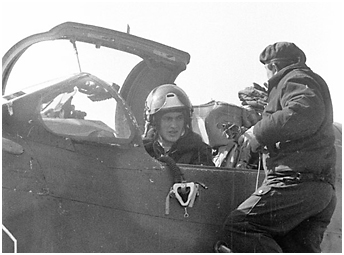 Ce MiG-21bis du 515.IAP basé ŕ Tököl en Hongrie, était equipé au-dessus du viseur tęte haute
d'un boîtier (ci-contre) destiné ŕ l'armement et au largage d'une bombe nucléaire - voir également le chapitre "Les remorqueurs
de cibles." Le pilote de cet appareil était Sergey Chevtchenko, commandant en second actuel des VVS.
Ce MiG-21bis du 515.IAP basé ŕ Tököl en Hongrie, était equipé au-dessus du viseur tęte haute
d'un boîtier (ci-contre) destiné ŕ l'armement et au largage d'une bombe nucléaire - voir également le chapitre "Les remorqueurs
de cibles." Le pilote de cet appareil était Sergey Chevtchenko, commandant en second actuel des VVS.
© A.Timokhin.
This MiG-21bis of the 515.IAP stationed at Tököl in Hungary, was equipped with a control box
(see picture on the right) above the HUD to arm and drop a nuclear bomb - see also the chapter "Target towing flights."
The pilot of this aircraft was Sergei Shevchenko who is now deputy commander of the VVS. © A.Timokhin.
Several Soviet AF aircraft types were tasked with a secondary nuclear strike mission alongside their primary role.
The introduction of a specialised version of the MiG-21 in the second half of the 1960s expanded the nuclear potential
of Frontal Aviation. Because research into the nuclear role of the MiG-21 has not yet been sufficiently completed,
it can only be said that some models of that fighter were nuclear-capable. It is interesting to mention that the
MiG-21 was deployed not only to Fighter Regiments but to Fighter-Bomber Regiments as well. It at least partially
replaced the provisional MiG-17 "Fresco-C" fighter-bomber, which was incapable of nuclear operations. The Su-7
'Fitter-A' is usually considered to be the follow-up, the Su-7 being the Soviets' first tactical jet fighter-bomber,
but after the cancellation of production and deployment to fighter-bomber units the Su-7 was succeeded
by the MiG-21 in the fighter-bomber role. The MiG-21SMT "Fishber-K." which was almost solely used for nuclear
operations, was the conclusion of this development.
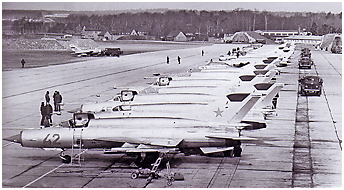
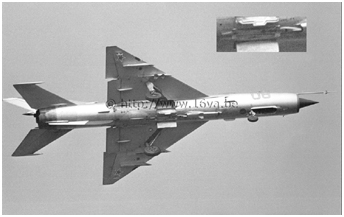 A summary of the MiG-21SMT leads to the conclusion that,
during the first half of the 1970s, approximately one-third of all Soviet fighter-bomber units were using the MiG-21
while the other two-thirds were flying Su-7s. Laymen were consequently unable to recognise whether MiG-21SMTs
were fighters or fighter-bombers. In both cases, however, the nuclear capability was already intended, and this
fact did not go unnoticed by the USMLM. Its 1973 annual report concludes: "The ground attack regiments
[Fighter-Bomber Regiments] continued extensive usage of the air-to-ground ranges during 1973. Their activities included
conventional bombing and strafing maneuvers as well as simulated nuclear deliveries. The figher-interceptor units
carried out intensive training with their "Fishbed" aircraft to increase their proficiency in performing their
dual role of ground attack and air defense. "Fishbeds" were observed performing LABS-type maneuvers over their
home bases during pilot categorization meets and utilized the air-to-ground ranges performing conventional bombing
and strafing maneuvers." The MiG-21SMT remained in service until the early 1980s when it was summarily replaced with
more modern types, such as the MiG-23MLD "Flogger-K" in fighter units and MiG-27M "Flogger-J" with fighter-bomber
units.
A summary of the MiG-21SMT leads to the conclusion that,
during the first half of the 1970s, approximately one-third of all Soviet fighter-bomber units were using the MiG-21
while the other two-thirds were flying Su-7s. Laymen were consequently unable to recognise whether MiG-21SMTs
were fighters or fighter-bombers. In both cases, however, the nuclear capability was already intended, and this
fact did not go unnoticed by the USMLM. Its 1973 annual report concludes: "The ground attack regiments
[Fighter-Bomber Regiments] continued extensive usage of the air-to-ground ranges during 1973. Their activities included
conventional bombing and strafing maneuvers as well as simulated nuclear deliveries. The figher-interceptor units
carried out intensive training with their "Fishbed" aircraft to increase their proficiency in performing their
dual role of ground attack and air defense. "Fishbeds" were observed performing LABS-type maneuvers over their
home bases during pilot categorization meets and utilized the air-to-ground ranges performing conventional bombing
and strafing maneuvers." The MiG-21SMT remained in service until the early 1980s when it was summarily replaced with
more modern types, such as the MiG-23MLD "Flogger-K" in fighter units and MiG-27M "Flogger-J" with fighter-bomber
units.
| Mission of no return? The range of the various MiG-21 versions preceeding the longer-range SMT models could be critical for the units not based in the vicinity of the frontline. The 515.IAP based at Tököl in Hungary was flying MiG-21bis models during the eighties. The 1.AE was nuclear capable and each pilot of the squadron had been assigned a target in Germany, Italy or Austria(!). Some targets were too far away (even with the external fuel tanks) and the pilots would have had to drop the nuclear bomb while flying horizontally and to eject when out of fuel, possibly above enemy territory. From Andrey Timokhin, 515.IAP. |
This chapter is an adaptation of the article entitled 'Nuclear Power' by Stefan Büttner, published in the March 2009 issue of Aircraft Illustrated (Ian Allan Publishing).
 |
Special weapons < Part 1 > Part 3 |
 |
Plan du site - Sitemap |  |
